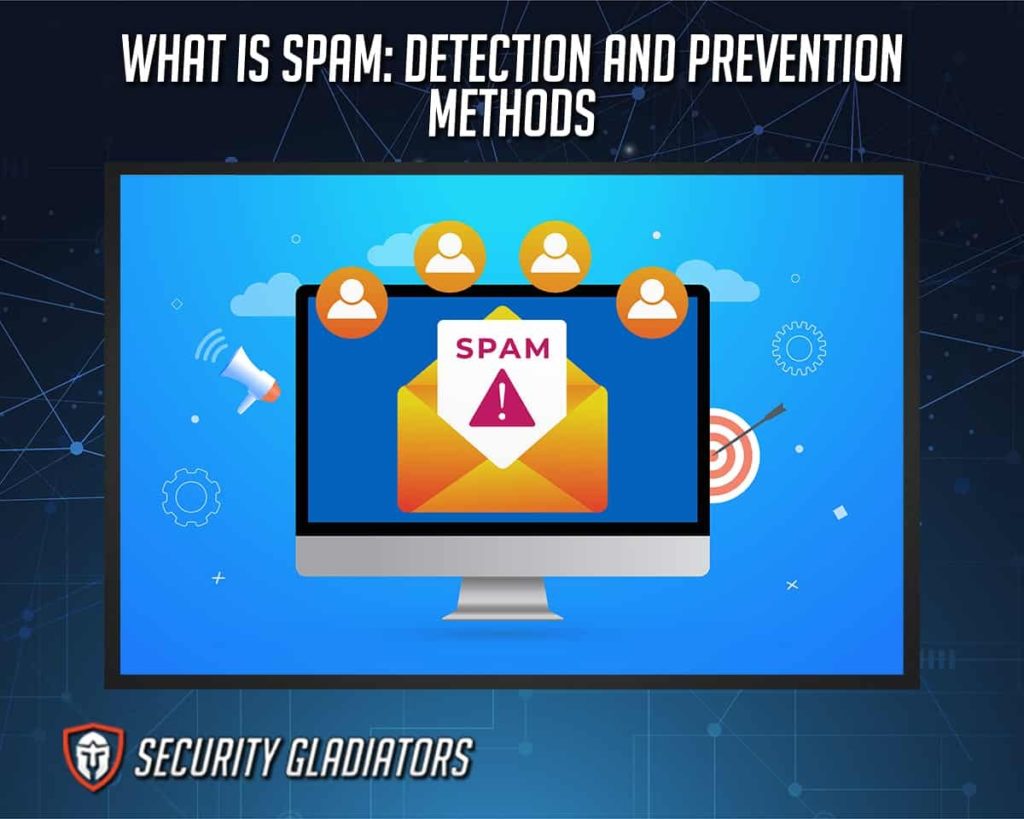There was a time when email services did not have good filters and everybody was getting spam all the time. In this guide, readers will learn what spam is and the different forms spam can take to disrupt operations on the internet.
By the end of this guide, readers will know more about the most common types of spam found on the internet, the dangers spam presents to online users and what users can do about spam to keep devices safe.

The harms of spam include malicious links, general annoyance, inboxes filled with useless email messages, financial losses to companies worldwide, widespread deceptive schemes and sale emails, copyright infringements and illicit content.
Some of the things users can do to recognize spam include looking closely at the sender of a given message, giving thought to the contents of the message, the subject of the message/email and looking for falsely advertised links within the sent messages. Another way to detect spam is to look for spelling mistakes, whether or not the content of the message is excessively forceful in wanting the user to click on the link or fill out a form and if there is a warning sign above the message indicating spam.
Pro Tip:
For prevention, users can use a good email service provider that can protect against spam, avoid giving out personal details to any website or forum that is not trustworthy, install security applications on any device with an internet connection, use strong passwords and contact the administrator.Any spam definition comes with an associated spam meaning. So while the definition of spam may involve unwanted and unsolicited commercial messages sent to many users, the meaning of spam is more specific. Mainly, unknown senders push out unwanted email messages to potentially thousands of users simultaneously with no other purpose than to advertise some fraudulent scheme. The presence of a fraudulent scheme is not always given, as legitimate businesses can sometimes also use spam.
Table of Contents
What are the Types of Spam?
The most dangerous spam types are email spam and phishing app spam. The types of spam are given below.
- Mobile Spam: Mobile phone spam is also known as m-spam. The mobile phone scam is mainly carried out by abusing the services mobile phones use for text messaging. Mobile spam usually takes the form of text messages that come loaded with advertisements. Sometimes mobile spam can target the owner of the mobile device as well.
- Link Spam: There is also link spam which is essentially when an entity embeds links into a self-owned website to push up the backlink count. The links can point to any important page on the website. In link spam, no consideration is given to the quality of the link (that is, the quality of content available wherever the link leads to) or even context (unrelated links are stuffed into a given page just to increase the link count). The main aim of link spam is to boost search engine rankings.
- Messaging Spam: Messaging spam is one of the most dangerous types of spam where actors target mobile users with SMS, IM services like WhatsApp or Telegram or direct messages via a given website feature (examples include the DM feature, available on both Twitter and Reddit).
- Email Spam: As the name suggests, email spam is a type of spam that involves unknown senders flooding inboxes with junk email. Most of the time, actors use entire email systems to send unsolicited emails to thousands of users simultaneously. The contents of email spam usually include advertising for a particular business or a call to action.
- Spam Calls: Another type of spam is spam calls. Spam calls represent any fraudulent activity carried out via a phone call. Spam calls aim to steal user information, leading to financial loss for the receiver of the spam call. The most prominent example of spam calls are robocalls.
- Spam Texts: There is also text spam where companies take advantage of the affordability of text messages to market different goals. Spam text messages are intrusive and offer no value to the user. Depending on the content, the spam text message may or may not be illegal. Companies that have access to telephone databases and systems in place to dial telephone numbers are the ones usually involved in sending spam text messages to users.
- Malspam: One type of spam is malspam which essentially means malicious spam. In this type of spam, the unknown spam sender can deliver malware to the recipient’s device. Malspam is usually carried out via malicious email attachments and/or links that the link sender wants the user to click on. Malspam can inject the user’s device with crypto miners, bots, trojans and even ransomware. The attachment may say it is an important PDF file or a PowerPoint presentation to make the email look legitimate.
- Fee Spam: There are also fee scam spams. This is where bad actors receive email messages that promise a monetary reward if the receiver of the message offers some cash in advance. The sender usually mentions the fee will be used to process the payment from, for example, Nigeria. Once the receiver of the messages pays up, the entity receiving the payment disappears.
What are the Most Common Examples of Web Spam?
The most common examples of web spam are given below.
- Dating and Adult Content
- Service Enrollment
- Financial Services and Awards
The examples mentioned above were chosen to represent web spam because of how widespread such web spam examples are, and the danger posed to online users who may not be fully aware of the consequences of engaging with such spam examples.
1. Dating and Adult Content
Perhaps the oldest type of web spam is dating and adult content spam. As the name suggests, this spamming method relies on pornographic and adult content. The reason dating and adult content has made the list is because of how prevalent dating and adult content still are.

The primary method of how bad actors find success is by sending explicit enhancement products and dating services messages to the target’s inbox.
Another reason dating and adult content spam has made the list is that this type of spam is the most difficult to stay away from. Typically adult content spam can bypass spam filters of most email services with ease.
If the user responds by clicking a link, that sends out the signal to even more adult content spammers. A given user might have visited an adult site most often to trigger such spam networks but such a condition isn’t always required. Just like any other type of spammers, adult content spammers purchase email addresses via brokers and traders.

Signing up for dating sites that do not take care of user data is another way how the personal information of users ends up in the hands of spammers. This is the reason why security experts recommend that users take five minutes to read the privacy policy and terms of use of any and all services that require an email address and/or any personal information.
2. Service Enrollment
Service enrollment spam is when bad actors take advantage of an overly confusing and complicated process to deceive people trying to sign up for some service and steal personal information and money.

There are many different kinds of service enrollment spam campaigns. The kind which suddenly becomes popular depends on the time of the year and what type of organizations have opened up mass enrollments.
For example, sometimes bad actors would pose as government representatives and claim to offer help for various enrollment programs. Essentially such actors dupe people looking to get enrolled in better programs at a lower price. Another common technique that service enrollment spammers use is scare tactics.
Bad actors don’t want people to think too hard on the enrollment program on offer and hence try to scare users into enrolling in a new program by saying that the opportunity will cease to exist very soon.
Service enrollment spam is on this list of most common examples of web spam because of how prevalent this type of spam is and how such a spam type can affect the most vulnerable people.
Bad actors don’t always use health insurance as an excuse to launch service enrollment campaigns, though. With help from robocalls, users can also get spam in the form of promotional gifts. In return, the spammer usually wants personal information. Similar types of brokers may also require personally identifiable information and/or Medicare ID number.

If bad actors can’t get to a potential target via health insurance spam messages,there is also a variant where targets are offered free health screening.
There are many other kinds of variations as well. But generally, readers should watch out for suspicious robocalls during open enrollment season when most people are changing health care plans and/or engaging with other service enrollment programs.
3. Financial Services and Awards
Financial services and award spam campaigns are other types of spam that scammers use to hurt people financially. Readers should understand that a good portion of spam messages are peddling scams, and hence scams and spam messages are closely related.

Bad actors communicate with potential victims using the usual ways such as email, text messages, SMS and call. The main aim is to convince the potential target of an investment opportunity with guaranteed returns. As is the case most of the time, the bad actors want the potential target to act immediately by either giving away personal information or worse financial information.
Financial services and awards spam campaigns have made this list because of how damaging such spam can be and how such campaigns target the most vulnerable of people. This includes older people who are unlikely to know much about the latest ways criminals can use spam to cause financial loss.
Note:
This is where readers should understand that bad actors can and do spoof text messages from legitimate banks and can imitate phone calls to try and persuade unwary users to part ways with money or personal details.Similar to other methods of spam campaigns, bad actors can use a great deal of variation in how a potential target is scammed via spam. During the tax season, scammers will usually send emails and text spam claiming to represent the Revenue and Customs department and demand unpaid taxes or offer financial services to get tax rebates.
In another variation, scammers can use email spam to inform users of an expiring TV license or DVLA. Once the user clicks on the spam links, legitimate-looking websites open up that ask users for personal details including payment information.

Financial services spam sometimes comes bundled with award spam as well. Award spam messages can be known as competition spam messages. In such types of spam messages, bad actors inform the potential target of huge winnings from a competition. Amounts can reach up to $1,000. After informing the potential target, the spam message requires the user to click on a link to claim the prize. Once the link is clicked, users are taken to a legitimate-looking but fraudulent website designed to extract personal and financial information.
4. Tech
Scammers carry out tech spam campaigns by letting potential targets know there is a problem with a given device. In order to fix the serious problem, tech spam messages want the owner of the device to contact tech support by only using the number provided. Sometimes tech spam messages point to a link that the user must click in order to get in touch with tech support.

Upon clicking the link provided, the user is taken to a fraudulent website for data extraction and exploitation. If the user calls the tech support number provided in the tech spam message, the call is picked up by a member of the scamming team. The customer support person then tries to extract as much information from the user as possible in order to successfully scam the person.
Tech spam messages usually take advantage of various other types of spam to increase the likelihood of success. Such techniques include email spoofing. Using email spoofing tech support, spammers are able to masquerade as representatives from a popular technology company such as Yahoo or Oracle. Other times, scammers might imitate a cybersecurity firm.
The top reason why tech support spam messaging has made it to the list is because of how easily tech spam messages are carried out and dupe unsuspecting users into giving up money via gift cards or straight credit card transfers.

A variation of the above-mentioned tech support spam campaign is when scammers want the user to believe there is a critical problem with the user’s device. To fix the problem, the tech support scam team wants a payment or access to the device. In order to seem more legitimate, tech support scam members can ask the user to use a legitimate money transfer app for payment.
Tech support spam campaigns may use any number of methods to communicate with users, including phone calls, pop-up notifications, online ads, websites in search engine results and more.
5. Health
Health spam messages are supposed to lure users into purchasing miracle tablets and non-proven medical cures for various diseases. Most of the time, scammers use email spam and advertisement spam to trick users into buying stuff that isn’t of any actual use.

Health spam messages have made the list because of how prevalent such type of web spam is, how many people buy into health spam messages and how difficult health spam campaigns are to differentiate from alternative medicine.
Most of the time, fraudsters will use non-proven (and unhelpful) health products or even a service (to cure some diseases) for a price. In the vast majority of cases, the miracle cure comes in the form of a pill or a cream that users have to keep applying for an extended period of time.
More specific examples include quick and easy cures for difficult to treat issues such as baldness, cancer, AIDS, acne, weight loss, impotence, GERD and tinnitus.
However, health spam campaigns have evolved just like any other type of spam. Now scammers behind such health spam messages are able to set up fake online pharmacies. Once a user checks in, these pharmacies offer cheap medicines and drugs. The other way spam messages increase effectiveness is by offering medicine without any prescription.

Now, unlike some of the other types of spam messages mentioned before, health spam messages sometimes send something to the scam victim. That is, medicine. But even if the user receives a medical product, there is no way to make sure that the product is not harmful or is even genuine. Most of the products sold through spam messages are harmful to health.
In fact, the least amount of harm that can come to the user via health spam messages is the loss of money. In a worst-case scenario, the user may end up causing serious damage to health.
Scammers behind such spam messages also bank on the fact that most of the users receiving spam messages will probably want to save money on medicine and consultation fees. Hence, by providing medicine cheaply and without prescription, users are duped into responding more easily.
What are the Dangers of Spam?

The main danger of spam is how scammers and other bad actors can use spam to launch many other kinds of cyberattacks. To start off, spam is annoying and degrades any user’s online experience. Moreover, spam messages can come with attachments that are infected with malware. Once the user downloads the attachment, the malware can infect the user’s device as well. Spam can also help cybercriminals launch phishing attacks. An expertly crafted spam message can hook users into clicking on a link to go to a website to buy some miracle product only to find that the website is a fraudulent version of a legitimate website. Another danger of spam is spear-phishing attacks where cybercriminals target individual users with legitimate personal information to increase the chances of a successful attack. Modern-day scammers are able to use spam texts to target more mobile users as well. Multiple data breaches over the last decade have provided hackers with millions of phone numbers of people living in various parts of the world. Using advanced software, hackers can send spam messages to pretty much everyone; that is another danger. Apart from spam messages tricking users into downloading malware or visiting malicious websites, there is also the danger of users losing personal information and having their online identity stolen.
What are the Prevention and Blocking Methods of Spam?
Here you can see the tips for preventing and blocking spam.
- The best method for preventing and blocking spam text and messages is to not use one’s personal email address anywhere online. The same goes for business email addresses as well. A good number of online users make the mistake of using personal email addresses to sign up for various applications, notifications, website alerts, and much more. Providing personal information with such carelessness provides scammers with the perfect opportunity to steal email addresses, build up a list and launch spam campaigns of all sorts.
- Learning how to block spam texts is all about using the right tools; tools such as antivirus applications and message filtering software. Such tools can block spam that comes via email (more specifically, email attachments and links).
- When it comes to blocking spam calls, the simplest method is to not pick up such calls and not respond to spam calls. Spam texts and calls primarily come from unknown sources (though sometimes hackers can compromise a user’s friend’s accounts and then send spam messages and calls from that account to dupe the user’s contacts) and contain malicious content.
- For iPhone users, understanding how to block spam calls on iPhone is about using the correct third-party apps and making the best use of the already available tools on the iOS. More specifically, users have to use the Silence Unknown Callers feature on the iPhone in order to block spam calls. As the name suggests, the Silence Unknown Callers feature will silence calls from unknown numbers and display such calls only in the Recent Calls section. To enable the Silence Unknown Calls feature, users first have to go to Settings and then to Phone. After that, scroll down until the Silence Unknown Callers option is visible. Once visible, click on the option to enable.
- For the iPhone, the App Store offers dedicated apps to block spam phone calls. Users are free to try out different apps to filter and block spam calls in order to see which one works best. Do take note that once such apps are downloaded, the user has to go to Settings and then to Phone. After that, the user has to go to the Call Blocking and Identification option and then enable the spam blocking app under Allow These Apps to Block Calls and Provider Caller ID.
- Modern (and trustworthy) email service providers offer many tools to combat all types of spam. Usually, there is a button right at the top alongside “compose” to make it easy for users to mark spam messages as spam. This trains the algorithm working behind the scenes to better detect spam. Over time, the spam detection mechanism gets better and better, thus providing more security to users from spam. Some email services also offer spam folders where users can see all the messages that the spam tool marked as spam. If there is a mistake, users can mark a message that has already judged spam as “not spam.”
- Website administrators can take several preventative measures against spam. Most of the protection against spam comes down to keeping the website’s software updated to the latest edition. Hackers (including scammers) like to exploit security vulnerabilities that are present in any software (a website’s software is no different). If the website administrator falls behind on the updates, that gives hackers the perfect opportunity to strike. Moreover, to block even more types of spam campaigns, website administrators need to implement Captcha technology. While such a mechanism may make logging in a slight pain, the benefit login pages would receive from such an implementation will be immense.
- Spreading the word about spam can help a bit. For example, if a user receives email spam or text spam from a contact then letting the contact know can help stop further spam. Users receiving the spam only have to inform the contact sending the spam that hackers have compromised the contact’s account and are generating spam via the account.
- Avoid posting contact information. The easiest way for scammers to find anyone’s contact information is to search online. Users who are not careful about posting personal information online are the ones that usually become a target of scams carried out via spam campaigns. To avoid such problems, users should always choose to hide their online presence, among other options.
How to Recognize a Spam
Some tips for recognizing spam are given below.
- Use services that offer advanced AI tools to enhance protections against phishing and other cyber threats including spam. As mentioned before, spam filters can greatly enhance effectiveness with help from AI tools. What’s more, almost all popular email services already use AI to improve spam filtering capabilities.
- Spam messages are expertly crafted. So much so that sometimes the spam messages inform the user about the lack of spam in the content of the said messages. Any message that announces a lack of spam in the contents (for example “this message is not spam”) is usually giving an indication that the message is indeed spam. In an attempt to dupe online users, spam messages aim to convince users that the only reason the spam message has dropped in the user’s inbox is that the user has registered with a given (fake) service.
- Another easy way to recognize spam is to look at the email attachments that the email spam comes with. Almost all spam messages come with attachments of some sort. Using attachments makes the task of looking legitimate easier for spammers. Most of the time, the spam message will ask the recipient to download and open the attachment in order to view the full statement or the complete catalog of a given product. Sometimes spammers will masquerade as a shipping company trying to convince the recipient to open the attachment to view tracking details. As mentioned before, if the recipient of any given message does not recognize and trust the source of the message, there is no reason to click any links within the message.
- One of the simplest steps to recognize a spam message is to look at how many links the message has. The hallmark of spam messages is that such messages contain a ton of links. Moreover, sometimes the URLs the links connect to have a weird naming methodology. The main aim of the spammer is to get the recipient of the spam message to go to fake websites and download fake apps that can then compromise personal information and load malware on the recipient’s device. Hovering over a suspicious link is usually enough to know if the link is malicious or not. If there is doubt about the URL address the link is connecting to then avoid clicking the link.
- An easy way to detect spam messages is to pay attention to any grammar mistakes or obvious incorrectly spelled words. Spam messages deploy different tricks to get past spam filters. One of those tricks is to deliberately make grammar and spelling mistakes. At other times the spammer simply doesn’t know the English language very well.
- If the address of the sender of the message is uncertain, then that is another helpful tool to recognize spam. While hackers now have the ability to use techniques such as email spoofing to send spam messages via legitimate-looking email addresses, the vast majority of spam messages still use unconventional and suspicious-sounding email addresses. Hence recipients should always double-check the email address of the sender carefully. If the sender’s email address doesn’t look like a standard address (in other words, the address has a weird combination of alphabet and numbers), then the message is probably spam.
- Any message that requires the recipient to not think much and act immediately is a spam message. This also holds when a message informs the user about a lifetime deal that sounds too good to be true. Any urgent call to action should make the recipient skeptical about the source of the message. The user should look out for common tricks such as massive discount offers or an IRS deadline to update personal info or a message from Sony to change password right now.
- Users can recognize spam messages by paying attention to the content of such messages as well. Almost all types of spam messages want the user to try out a magic pill or a technique to instantly cure a disease. A given message is spam if there is any mention about losing weight super fast or applying some oil to cure baldness in weeks. At other times spam messages would talk about a pill to get stronger or a get-rich-quick scheme for a limited time.
- One other method to recognize spam messages is to keep on top of one’s personal activity. So if the user has not tried to sign in from an unknown location, there is no reason for a service to ask the user to take notice of suspicious account activity. Similarly, spam messages may talk about some payment not going through or ask the user to contact an organization to confirm the authenticity of the purchase or check delivery information on a package. Users who are not careless about such matters in real life have less chance of being duped by spammers via spam messages.
What are the Best Tools to Recognize and Block Spam?
The best anti-spam tools to recognize and block spam are given below.
- Mimecast
- ORF Fusion
- SPAMfighter
- MX Guarddog
- Comodo Dome Antispam
- SpamSieve
- ZeroSpam
- Mailwasher
- Spam Titan
- N-able Mail Assure
- Nomorobo Robocall Blocking
- RoboKiller
- YouMail
- Truecaller
- Call Control Home
- RoboShield
- Hiya
- T-Mobile Name ID
Is an Antivirus Program Effective to Prevent Spamming?
Yes, but not a lot. That is because most antivirus applications are optimized to detect and delete malware, trojans and viruses. The developers of such security products haven’t designed antivirus applications to be effective against spam or any other kind of malicious email. With that said, the cybersecurity market has started to offer antivirus programs that come with built-in spam solutions such as filters and advanced detection tools.

Sometimes users want to prevent spam because spam can drop malware on a given device. However, if there is a good antivirus program in place then the malware from the spam message would matter little. As soon as the malware drops on the system and tries to do something harmful, the antivirus program will kick in and delete the malware.
In that respect, antivirus programs are somewhat effective at preventing spam since the spam message can’t harm the user’s device.
Modern antivirus products also come with ad blockers and anti-tracker tools which can further protect against spam. More specifically, hackers that use pop-up ads (among any other type of advertisement) to spam users can be blocked via the ad blocker component of antivirus programs. As a result, the user is able to prevent getting spammed.
Some spamming methods want the user to click on a malicious link and then submit personal information. Some antivirus products can block phishing websites and links as well. As mentioned before, antivirus programs may not provide direct protection against spam but do protect users from spam indirectly.

Different antivirus products take different approaches to handle spam. Some use smart firewalls to keep spam out of the user’s inbox while others are able to read and interpret email messages to see if there is any spam involved. The best antivirus programs come with dedicated components to protect users against spam. Antivirus programs with anti-spam components also keep an updated list of filters to block the latest versions of already established spam types. This is where anti-phishing components and malicious URL blocking features can also help against spam.
Elite-level antivirus products offer antispam components in the form of add-ons that support popular email service providers such as Outlook and Outlook Express. Such comprehensive spam filters have anti-phishing properties and content and attachment filters.
Can a VPN Prevent Spamming by Hiding Your Information?
Yes, VPN services can prevent the harm caused by spam messages by hiding the user’s information. Like antivirus products, VPN services are not made for detecting and deleting spam messages.
However, VPNs can indirectly protect users against spam. For example, VPN services are great at hiding and securing internet traffic. That helps users keep safe from malicious websites. And if the user is protected from malicious websites, that automatically means some protection from spam.

Spammers need email addresses to send spam. And even though hackers have a lot of ways to get email addresses, one of the ways is to hijack non-encrypted web traffic. VPNs encrypt web traffic which, again, indirectly protects users against potential spam.
Many spamming campaigns eventually leverage other cyberattacks such as malware and phishing to bring harm to users. Elite VPNs have the ability to detect and block malicious websites. That means even if the user responds to a spam message by going to a website, a VPN can block the website to protect the user.
Similarly, some VPNs also block phishing attempts. Other VPNs come with dedicated ad blockers and anti-trackers which means spammers can’t just use online ads to get a message across to the user to click on and hence get scammed.
Note:
Readers should keep in mind that not all VPNs come with ad blockers, anti-trackers or malicious URL blockers. Only the best VPN services do.So, does VPN prevent phishing, spam and junk mail? The definitive answer is yes, but only if the user signs up for top-of-line VPN services.
How Carriers Label Spam Callers to Prevent Spamming?
Almost all the best carriers label spam callers to prevent spamming. Most carriers label spam callers by words such as “Spam Likely” or “Fraud Risk” or “Marked as Spam by many others.”

In such cases, users only need to understand such labels as warnings. For example, T-Mobile, one of the largest US telecommunications companies, makes use of the term “Scam Likely.” Sometimes the company uses the Caller ID screen to label spam calls as “Nuisance Likely.”
All of such terms mean that according to the telephone carrier’s systems, the call is highly likely to be a robocall or spam.
Another big telecommunications company AT&T uses a different method to label spam calls such as “Fraud Risk” or “Spam Risk.” Even though the terms are different, the end objective remains the same: to let the user know that the incoming call may be a robocall.
Verizon takes a different approach and straight out labels potential suspicious incoming calls as “Potential Spam.” If Verizon is unable to verify a number, the telecommunications company marks the call as Potential Spam. Like the other telecommunications services mentioned so far, the facility to label robocalls is absolutely free.
Another company, Sprint, goes (or rather went, as will be explained in a bit) even further and warns users with labels such as “Potential Fraud.” Sprint calls this functionality Sprint Call Screener Basic. All Sprint users can access this facility for free. With that said, readers should know that T-Mobile and Sprint merged in 2020, and since then, there has been no definitive answer to which labels T-Mobile will finally stick with.
As pointed out earlier, the best method to deal with spam is to not pick up the spam call or reply to spam messages (email and text). Once a user takes no action, the spam calls should automatically go to the voicemail facility. It goes without saying that if the call is indeed legitimate, the person at the other end will probably leave a message or a text.

Readers should also understand that all the carriers mentioned above can only warn users of potential spam calls. However, the user will still see the spam number, and the notification will come up on the screen when a spam call arrives. Users have to use various robocall blocking applications on mobile devices to actually block spam calls and never receive any notification about spam calls. The easiest way to pick a good robocall blocking application is to go to either Google Play Store (for Android) and/or the App Store (for iOS), search for robocall blocking apps and pick the one that has a high number of votes and more stars.
The latest versions of both Android and iOS can block callers as well. Usually, the option to block spam calls is available in Settings and then Caller ID & Spam. Users can also take a look at the Recent calls section and then select the spam number to mark the number either as “Block” or “Report Call as Spam.”
Note:
Users wanting to get rid of spam calls can also sign up at the National Do Not Call Register to reduce the chances (by however little margin) of getting spam in the future.Apart from that, all the carriers mentioned above have paid call filter facilities that users can sign up for with a subscription package.
Should You Report Spam?
Yes, users should report spam and scam messages to make the job of law enforcement authorities somewhat easier.

The first step towards reporting spam messages is to mark such messages as spam. All good email service providers offer the facility to mark messages as spam or scam. There is also an option of marking a particular message as “junk.” In a best-case scenario, users should first mark the spam message as “junk” and then go to the junk folder and mark the message as spam.
The actual steps to marking a message as junk or spam differ for each email service, but the most common set of steps include selecting the spam message and then performing a right-click on the spam message. From the context menu, go to the option that says “Mark This As” and then pick “spam” or “junk.”
Users can always report spam messages (trying to scam people) to the state consumer protection office. In the case of a user suffering financial losses, the police can also be contacted.
There are also websites available that enable users to report spam messages to the federal government. Of course, a single report won’t help the federal government catch the perpetrators of spam campaigns looking to scam people. But even a single report can help law enforcement agencies form patterns which eventually leads to the groups launching spam campaigns to scam people. With the help of spam reports, the government may also take action against the services enabling spammers/scammers to reach a wide audience.
There is no way to recover money or get in touch with an agency over a spam report, though.

The agency that deals with all sorts of scams carried out via spam messages is the Federal Trade Commission (FTC). To report fraud, the FTC has set up a website that users can access by searching for FTC complaint assistant. There is also a helpline 1-877-382-4357 to assist people in reporting scams. The FTC usually deals with student loan scams, fake check scams, tech support scams, email scams and phone call scams.
Separate from the FTC’s official website for reporting scams via spam, for international scam campaigns, users have to access the Internet Crime Complaint Center. This website allows users to report fake email addresses, malware, websites and other methods used to launch spam campaigns. For international scams, users have to go to the e-consumer website to report. As mentioned before, even though a single report won’t probably lead to the criminals behind such campaigns, that single report can help law enforcement agencies detect trends and stop future scams.
For robocalls, users can also contact the SSA Inspector General’s official website. The contact number is 1-800-269-0271 for users who want to report via phone.
What are the Differences between Spamming and Phishing?

The primary difference (apart from the phishing definition and spamming definition) between spamming and phishing is that spamming involves tactics to market and/or sell useless goods and services to users who did not request to receive any information regarding that. Phishing involves specific attempts to steal the personal information of the target and cause financial harm in the end.
Between phishing and spamming, phishing is more dangerous than spamming since not all spam is trying to explicitly steal user information and cause financial harm, while the vast majority of phishing is done to harm the target financially. Both spam and phishing attacks make use of social engineering techniques to increase the chances of a successful campaign.
Phishing is a bonafide cyberattack where hackers masquerade as trustworthy or popular entities and engage in fraudulent communications to trick online users into giving up sensitive information. Other times phishing attacks aim to install malware on the target machine.
Readers should note that there is definitely an overlapping area between spamming and phishing depending on the specific techniques used by the criminals behind a given spam or phishing campaign.

